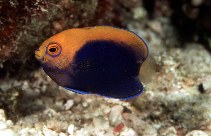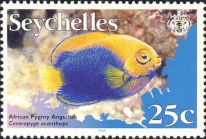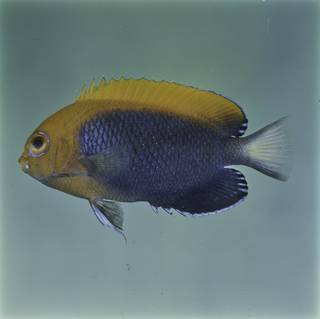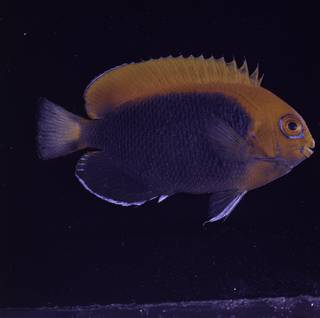WoRMS taxon details
Centropyge acanthops (Norman, 1922)
211775 (urn:lsid:marinespecies.org:taxname:211775)
accepted
Species
Centropyges acanthops (Norman, 1922) · unaccepted (misspelling)
Holacanthus acanthops Norman, 1922 · unaccepted
Xiphipops acanthops (Norman, 1922) · unaccepted
marine, brackish, fresh, terrestrial
Not documented
Description Inhabits areas of coral rubble and frequently occurs in small groups of up to about 10 individuals. Feeds on small...
Description Inhabits areas of coral rubble and frequently occurs in small groups of up to about 10 individuals. Feeds on small invertebrates and algae (Ref. 5503). Spawning at sunset; male stimulating the emission of eggs with biting motions on female's abdomen; eggs released and abandoned in open waters without any particular parental care (Ref. 5503). Popular aquarium fish in Natal. Occasionally exported from Kenya. [details]
Froese, R. and D. Pauly. Editors. (2024). FishBase. Centropyge acanthops (Norman, 1922). Accessed through: World Register of Marine Species at: https://www.marinespecies.org/aphia.php?p=taxdetails&id=211775 on 2024-04-18
Date
action
by
![]() The webpage text is licensed under a Creative Commons Attribution-Noncommercial 4.0 License
The webpage text is licensed under a Creative Commons Attribution-Noncommercial 4.0 License
basis of record
Froese, R. & D. Pauly (Editors). (2023). FishBase. World Wide Web electronic publication. version (02/2023)., available online at https://www.fishbase.org [details]
ecology source Looby, A.; Erbe, C.; Bravo, S.; Cox, K.; Davies, H. L.; Di Iorio, L.; Jézéquel, Y.; Juanes, F.; Martin, C. W.; Mooney, T. A.; Radford, C.; Reynolds, L. K.; Rice, A. N.; Riera, A.; Rountree, R.; Spriel, B.; Stanley, J.; Vela, S.; Parsons, M. J. G. (2023). Global inventory of species categorized by known underwater sonifery. <em>Scientific Data.</em> 10(1). (look up in IMIS), available online at https://doi.org/10.1038/s41597-023-02745-4 [details]
ecology source Looby, A.; Erbe, C.; Bravo, S.; Cox, K.; Davies, H. L.; Di Iorio, L.; Jézéquel, Y.; Juanes, F.; Martin, C. W.; Mooney, T. A.; Radford, C.; Reynolds, L. K.; Rice, A. N.; Riera, A.; Rountree, R.; Spriel, B.; Stanley, J.; Vela, S.; Parsons, M. J. G. (2023). Global inventory of species categorized by known underwater sonifery. <em>Scientific Data.</em> 10(1). (look up in IMIS), available online at https://doi.org/10.1038/s41597-023-02745-4 [details]
 Present
Present  Present in aphia/obis/gbif/idigbio
Present in aphia/obis/gbif/idigbio  Inaccurate
Inaccurate  Introduced: alien
Introduced: alien  Containing type locality
Containing type locality
From other sources
Description Inhabits areas of coral rubble and frequently occurs in small groups of up to about 10 individuals. Feeds on small invertebrates and algae (Ref. 5503). Spawning at sunset; male stimulating the emission of eggs with biting motions on female's abdomen; eggs released and abandoned in open waters without any particular parental care (Ref. 5503). Popular aquarium fish in Natal. Occasionally exported from Kenya. [details]
| Language | Name | |
|---|---|---|
| English | orangeback angelfish | [details] |
To Barcode of Life (13 barcodes)
To Biodiversity Heritage Library (1 publication)
To Biodiversity Heritage Library (2 publications) (from synonym Holacanthus acanthops Norman, 1922)
To European Nucleotide Archive (ENA)
To FishBase
To FishBase (from synonym Xiphipops acanthops (Norman, 1922))
To FishBase (from synonym Holacanthus acanthops Norman, 1922)
To FishBase (from synonym Centropyges acanthops (Norman, 1922))
To FishBase images (Centropyge acanthops, Seychelles, by Randall, J.E.)
To GenBank (30 nucleotides; 41 proteins)
To GenBank (30 nucleotides; 41 proteins) (from synonym Xiphipops acanthops (Norman, 1922))
To GenBank (30 nucleotides; 41 proteins) (from synonym Holacanthus acanthops Norman, 1922)
To IUCN Red List (Least Concern)
To NMNH Extant Collection (Centropyge acanthops FIN031966 Slide 120 mm)
To NMNH Extant Collection (Centropyge acanthops FIN031967 Slide 120 mm)
To ITIS
To Biodiversity Heritage Library (1 publication)
To Biodiversity Heritage Library (2 publications) (from synonym Holacanthus acanthops Norman, 1922)
To European Nucleotide Archive (ENA)
To FishBase
To FishBase (from synonym Xiphipops acanthops (Norman, 1922))
To FishBase (from synonym Holacanthus acanthops Norman, 1922)
To FishBase (from synonym Centropyges acanthops (Norman, 1922))
To FishBase images (Centropyge acanthops, Seychelles, by Randall, J.E.)
To GenBank (30 nucleotides; 41 proteins)
To GenBank (30 nucleotides; 41 proteins) (from synonym Xiphipops acanthops (Norman, 1922))
To GenBank (30 nucleotides; 41 proteins) (from synonym Holacanthus acanthops Norman, 1922)
To IUCN Red List (Least Concern)
To NMNH Extant Collection (Centropyge acanthops FIN031966 Slide 120 mm)
To NMNH Extant Collection (Centropyge acanthops FIN031967 Slide 120 mm)
To ITIS



